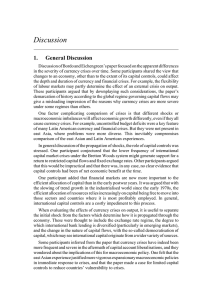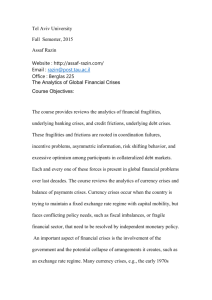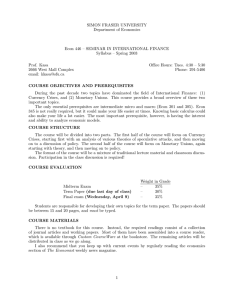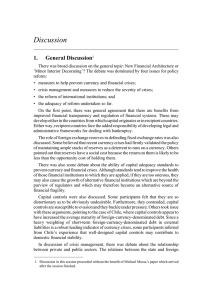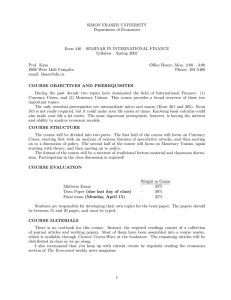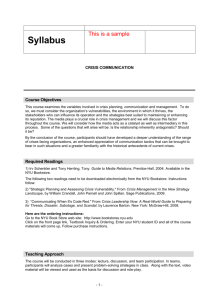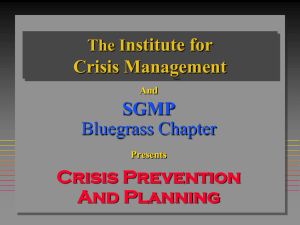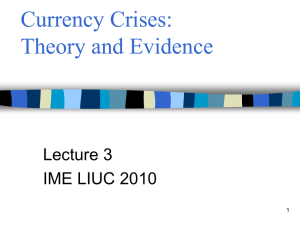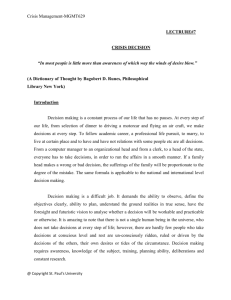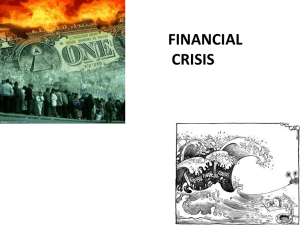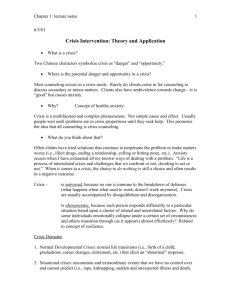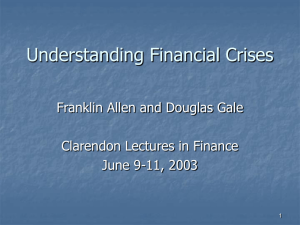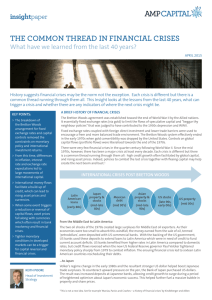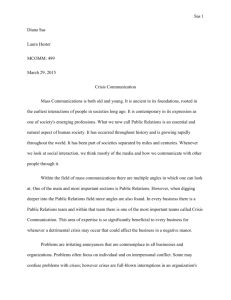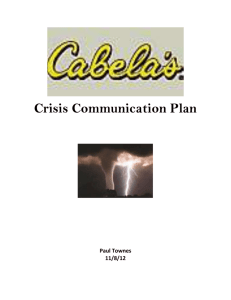This course deals with the functioning of the international monetary
advertisement
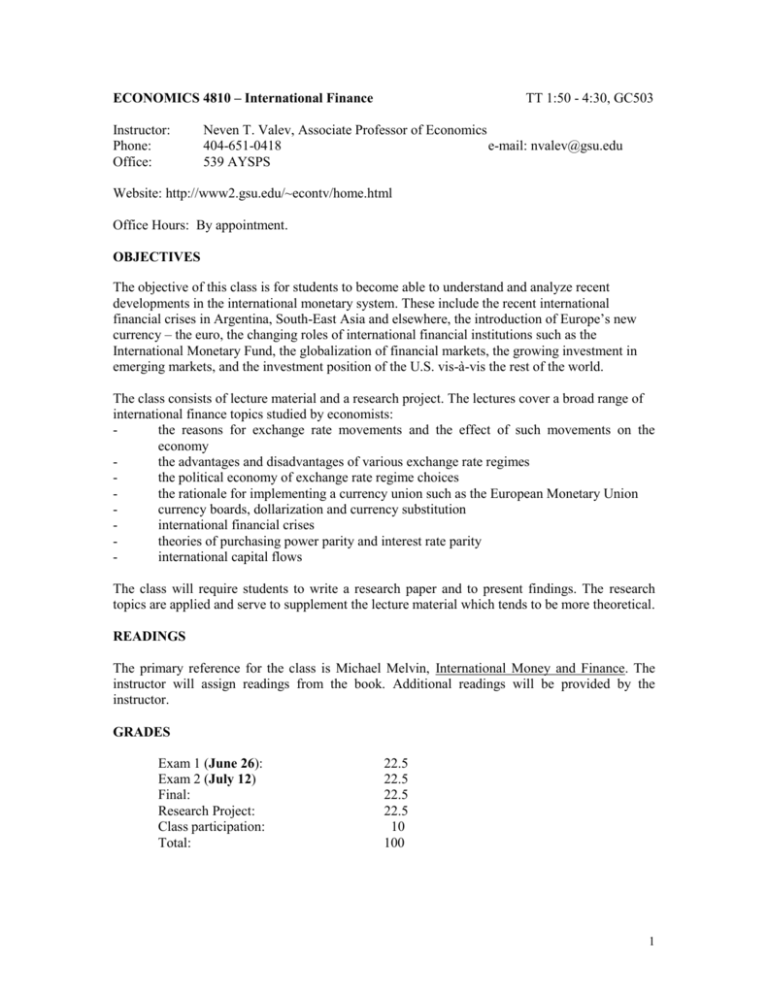
ECONOMICS 4810 – International Finance Instructor: Phone: Office: TT 1:50 - 4:30, GC503 Neven T. Valev, Associate Professor of Economics 404-651-0418 e-mail: nvalev@gsu.edu 539 AYSPS Website: http://www2.gsu.edu/~econtv/home.html Office Hours: By appointment. OBJECTIVES The objective of this class is for students to become able to understand and analyze recent developments in the international monetary system. These include the recent international financial crises in Argentina, South-East Asia and elsewhere, the introduction of Europe’s new currency – the euro, the changing roles of international financial institutions such as the International Monetary Fund, the globalization of financial markets, the growing investment in emerging markets, and the investment position of the U.S. vis-à-vis the rest of the world. The class consists of lecture material and a research project. The lectures cover a broad range of international finance topics studied by economists: the reasons for exchange rate movements and the effect of such movements on the economy the advantages and disadvantages of various exchange rate regimes the political economy of exchange rate regime choices the rationale for implementing a currency union such as the European Monetary Union currency boards, dollarization and currency substitution international financial crises theories of purchasing power parity and interest rate parity international capital flows The class will require students to write a research paper and to present findings. The research topics are applied and serve to supplement the lecture material which tends to be more theoretical. READINGS The primary reference for the class is Michael Melvin, International Money and Finance. The instructor will assign readings from the book. Additional readings will be provided by the instructor. GRADES Exam 1 (June 26): Exam 2 (July 12) Final: Research Project: Class participation: Total: 22.5 22.5 22.5 22.5 10 100 1 The exams are based on the lecture materials, on assigned readings, and on class presentations by research groups. The exams are a combination of multiple choice questions and short essay questions. Grades are assigned as follows: 90 – 100 A; 80-89 B; 70 – 79 C; 60 – 69 D; <60 F. There are no “+” or “-“. RESEARCH PROJECT Students will form groups of 5 and will choose a topic from the list provided below. The research project consists of two parts: - writing a research paper - presentation in class 70 percent of the grade for the project will come from the paper, 30 percent will come from the presentation. The paper should be about 15 pages long, double spaced, font 12 using Microsoft Word. The criteria for grading the paper are the following: 1) The amount of relevant information. Use about 10-15 sources which may include books, articles, information from Internet cites, etc.; 2) Is the paper structured well? Do the parts follow logically? The presentations use Power Point. Take about 50 minutes to do the presentation and about 20 minutes for questions and answers How to form groups Send me an e-mail with your top three choices for a project from the list below by Wednesday (June 13) 3:00 PM. The assignment to groups will be on a first come – first serve basis. I will randomly assign students who do not send me an e-mail. Sequence of presentations International Financial Institutions (June 28) – Discuss the roles of the major international organizations involved in the global economy and the global financial markets: the IMF, the World Bank, the Bank for International Settlements; the WTO and others. What are their main functions? In what ways are they similar or different? Why have many of them received criticism in recent years? The gold standard regime (July 3) – The gold standard regime prevailed in the world economy before the world wars and for a brief period between the wars. It has many proponents today. Explain how it functions. What were the costs and benefits of the gold standard regime? Why it could not be sustained? How would the world economy look today if the gold standard were restored? International banking (July 5) – Banking has become a global game with large institutions moving large sums of money across national borders. What are the biggest players in this market? What countries are the largest borrowers? What types of credits are extended? What are the dynamics over time? How are US banks involved? What regulations govern international banking? How banks deal with default by countries that cannot pay? 2 European Monetary Union (July 10) – In 2001 several countries in Europe abandoned their currencies and adopted a common currency called the euro. What is the history of this institution? What is the institutional structure of the EMU? What is the effect on the member countries? Are there any positive or negative consequences for the U.S.? What are the prospects for new members of the EMU? International Investments (July 17) – Globalization has been characterized by a massive increase in cross border investments. What types of investments are moving cross borders? From where to where? What are the dynamics over time? Are these levels of international investment unprecedented in a historical context? What factors motivate international investment? What are the positive and negative effects of international investments for the recipient countries? Financial crises in South-East Asia (July 19) - In 1997-98, South Korea, Thailand, Indonesia, and several other countries in that region experienced a sharp devaluation of their currencies and severe recessions. What went wrong? What are the competing explanations for the crises? How were the crises managed? What was the role of the IMF? Have these economies recovered? The crisis in Russia in 1998 (July 24) – Russia experienced a severe economic and financial crisis in 1998. Describe what happened. What were the origins of the crisis? Was the crisis linked to the process of economic transformation of the Russian economy and political systems? What was the effect of the crisis in Russia on the international financial markets? Hedge funds and private equity funds (July 26) – What do we mean by the two types of funds? What do they do? When did they become prominent players in the financial markets? What were some of the most serious crises associated with their operation (e.g. Long-Term Capital Management)? 3
